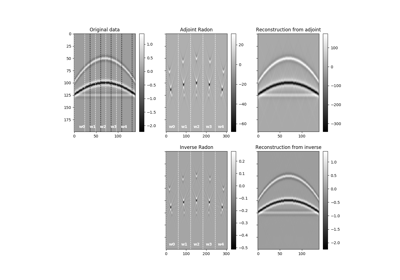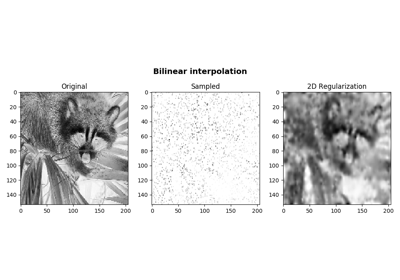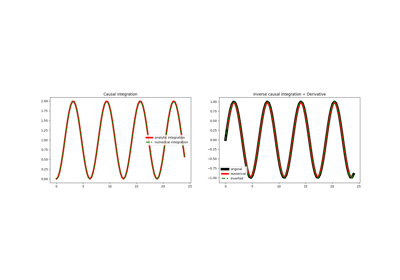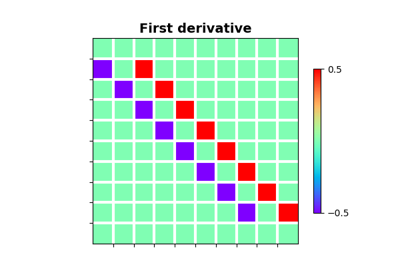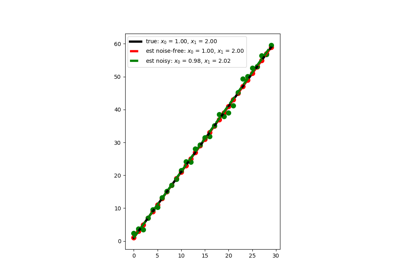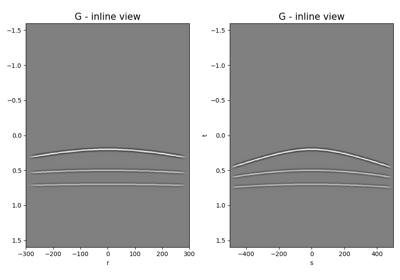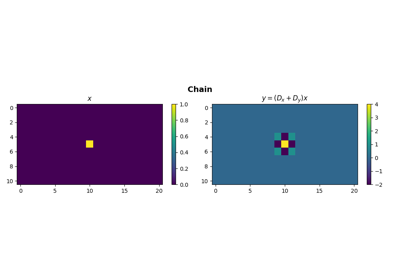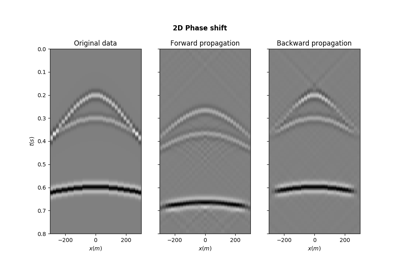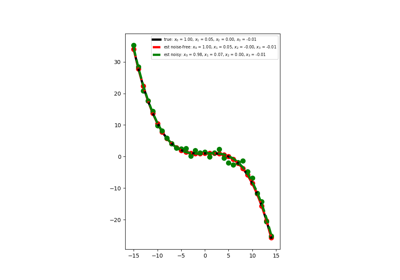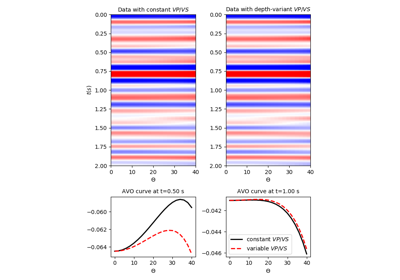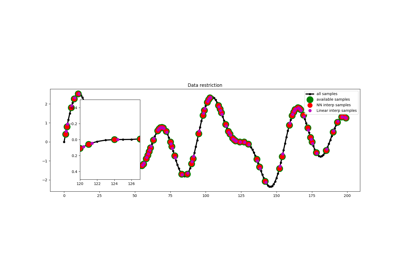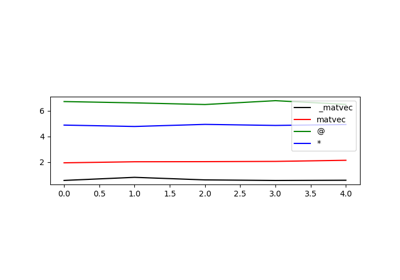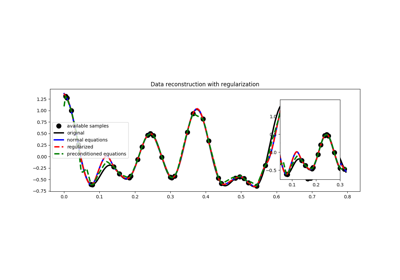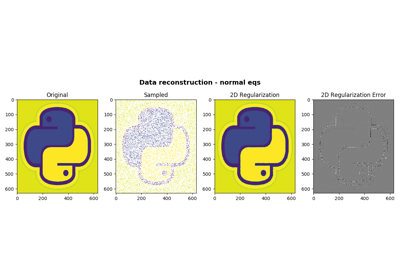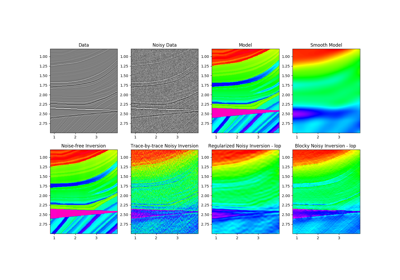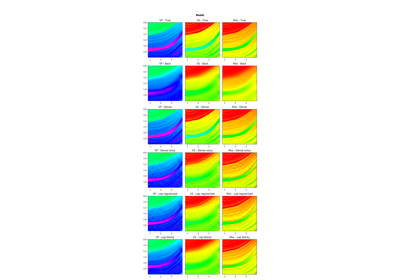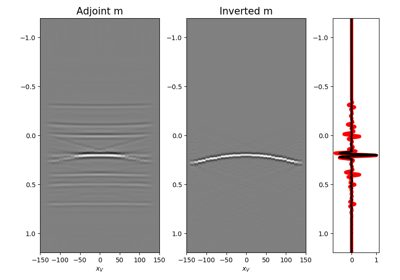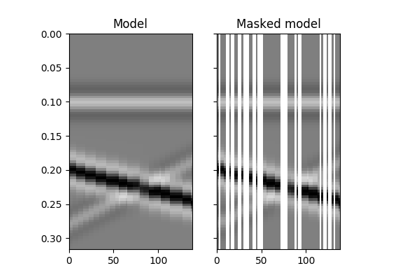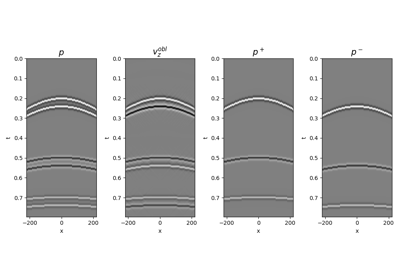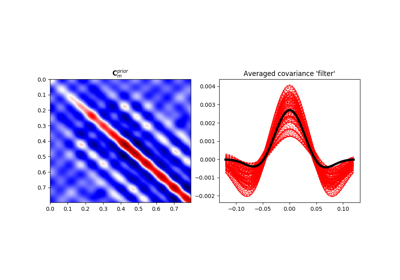pylops.LinearOperator¶
-
class
pylops.LinearOperator(Op=None, explicit=False)[source]¶ Common interface for performing matrix-vector products.
This class is an overload of the
scipy.sparse.linalg.LinearOperatorclass. It adds functionalities by overloading standard operators such as__truediv__as well as creating convenience methods such aseigs,cond, andconj.Note
End users of PyLops should not use this class directly but simply use operators that are already implemented. This class is meant for developers and it has to be used as the parent class of any new operator developed within PyLops. Find more details regarding implementation of new operators at Implementing new operators.
Parameters: - Op :
scipy.sparse.linalg.LinearOperatororscipy.sparse.linalg._ProductLinearOperatororscipy.sparse.linalg._SumLinearOperator Operator
- explicit :
bool Operator contains a matrix that can be solved explicitly (
True) or not (False)
Methods
__init__(self[, Op, explicit])Initialize this LinearOperator. adjoint(self)Hermitian adjoint. apply_columns(self, cols)Apply subset of columns of operator cond(self, \*\*kwargs_eig)Condition number of linear operator. conj(self)Complex conjugate operator div(self, y[, niter])Solve the linear problem \(\mathbf{y}=\mathbf{A}\mathbf{x}\). dot(self, x)Matrix-matrix or matrix-vector multiplication. eigs(self[, neigs, symmetric, niter])Most significant eigenvalues of linear operator. matmat(self, X)Matrix-matrix multiplication. matvec(self, x)Matrix-vector multiplication. rmatmat(self, X)Adjoint matrix-matrix multiplication. rmatvec(self, x)Adjoint matrix-vector multiplication. todense(self)Return dense matrix. transpose(self)Transpose this linear operator. -
div(self, y, niter=100)[source]¶ Solve the linear problem \(\mathbf{y}=\mathbf{A}\mathbf{x}\).
Overloading of operator
/to improve expressivity of Pylops when solving inverse problems.Parameters: - y :
np.ndarray Data
- niter :
int, optional Number of iterations (to be used only when
explicit=False)
Returns: - xest :
np.ndarray Estimated model
- y :
-
todense(self)[source]¶ Return dense matrix.
The operator in converted into its dense matrix equivalent. In order to do so, the operator is applied to an identity matrix whose number of rows and columns is equivalent to the number of columns of the operator. Note that this operation may be costly for very large operators and it is only suggest it to use as a way to inspect the structure of the matricial equivalent of the operator.
Returns: - matrix :
numpy.ndarray Dense matrix.
- matrix :
-
eigs(self, neigs=None, symmetric=False, niter=None, **kwargs_eig)[source]¶ Most significant eigenvalues of linear operator.
Return an estimate of the most significant eigenvalues of the linear operator. If the operator has rectangular shape (
shape[0]!=shape[1]), eigenvalues are first computed for the square operator \(\mathbf{A^H}\mathbf{A}\) and the square-root values are returned.Parameters: - neigs :
int Number of eigenvalues to compute (if
None, return all). Note that forexplicit=False, only \(N-1\) eigenvalues can be computed where \(N\) is the size of the operator in the model space- symmetric :
bool, optional Operator is symmetric (
True) or not (False). User should set this parameter toTrueonly when it is guaranteed that the operator is real-symmetric or complex-hermitian matrices- niter :
int, optional Number of iterations for eigenvalue estimation
- **kwargs_eig
Arbitrary keyword arguments for
scipy.sparse.linalg.eigsorscipy.sparse.linalg.eigsh
Returns: - eigenvalues :
numpy.ndarray Operator eigenvalues.
Notes
Eigenvalues are estimated using
scipy.sparse.linalg.eigs(explicit=True) orscipy.sparse.linalg.eigsh(explicit=False).This is a port of ARPACK [1], a Fortran package which provides routines for quickly finding eigenvalues/eigenvectors of a matrix. As ARPACK requires only left-multiplication by the matrix in question, eigenvalues/eigenvectors can also be estimated for linear operators when the dense matrix is not available.
[1] http://www.caam.rice.edu/software/ARPACK/ - neigs :
-
cond(self, **kwargs_eig)[source]¶ Condition number of linear operator.
Return an estimate of the condition number of the linear operator as the ratio of the largest and lowest estimated eigenvalues.
Parameters: - **kwargs_eig
Arbitrary keyword arguments for
scipy.sparse.linalg.eigsorscipy.sparse.linalg.eigsh
Returns: - eigenvalues :
numpy.ndarray Operator eigenvalues.
Notes
The condition number of a matrix (or linear operator) can be estimated as the ratio of the largest and lowest estimated eigenvalues:
\[k= \frac{\lambda_{max}}{\lambda_{min}}\]The condition number provides an indication of the rate at which the solution of the inversion of the linear operator \(A\) will change with respect to a change in the data \(y\).
Thus, if the condition number is large, even a small error in \(y\) may cause a large error in \(x\). On the other hand, if the condition number is small then the error in \(x\) is not much bigger than the error in \(y\). A problem with a low condition number is said to be well-conditioned, while a problem with a high condition number is said to be ill-conditioned.
-
conj(self)[source]¶ Complex conjugate operator
Returns: - conjop :
pylops.LinearOperator Complex conjugate operator
- conjop :
-
apply_columns(self, cols)[source]¶ Apply subset of columns of operator
This method can be used to wrap a LinearOperator and mimic the action of a subset of columns of the operator on a reduced model in forward mode, and retrieve only the result of a subset of rows in adjoint mode.
Note that unless the operator has
explicit=True, this is not optimal as the entire forward and adjoint passes of the original operator will have to be perfomed. It can however be useful for the implementation of solvers such as Orthogonal Matching Pursuit (OMP) that iteratively build a solution by evaluate only a subset of the columns of the operator.Parameters: - cols :
list Columns to be selected
Returns: - colop :
pylops.LinearOperator Apply column operator
- cols :
- Op :
